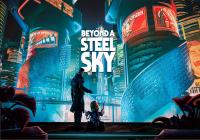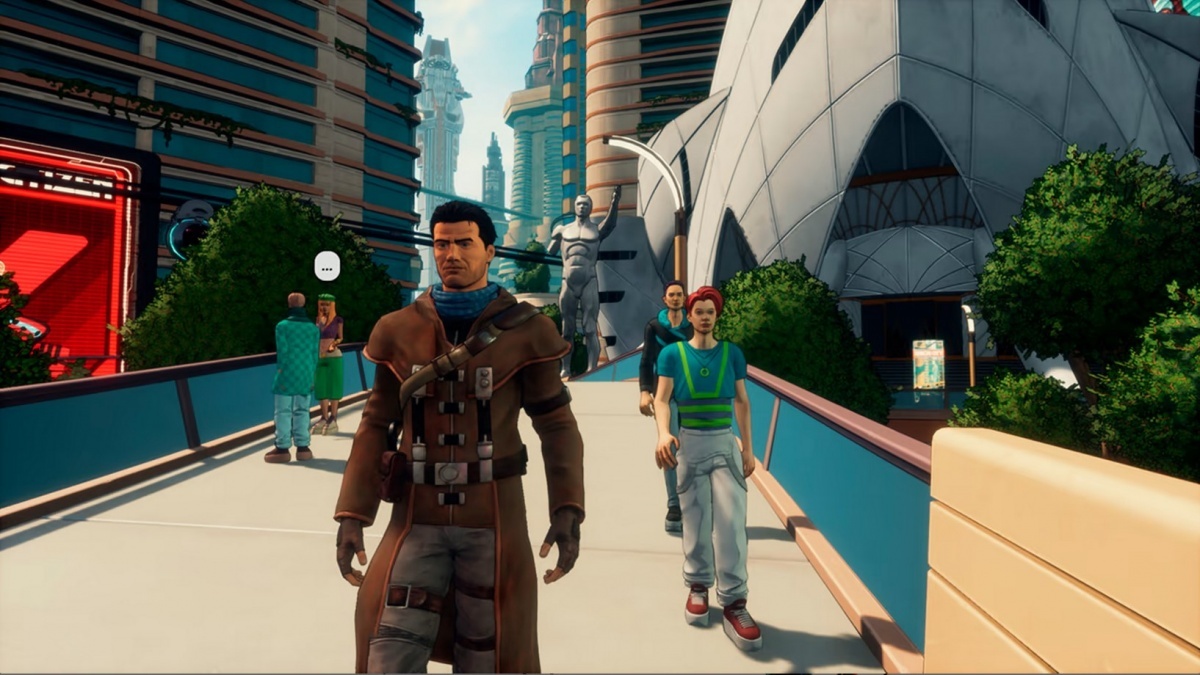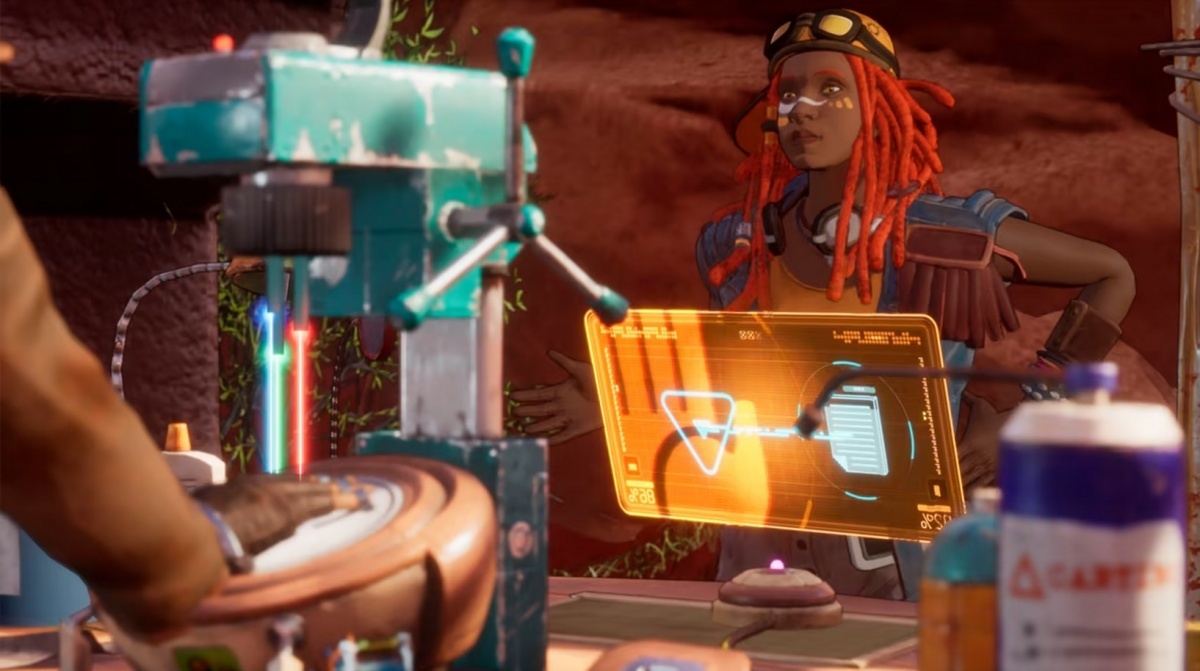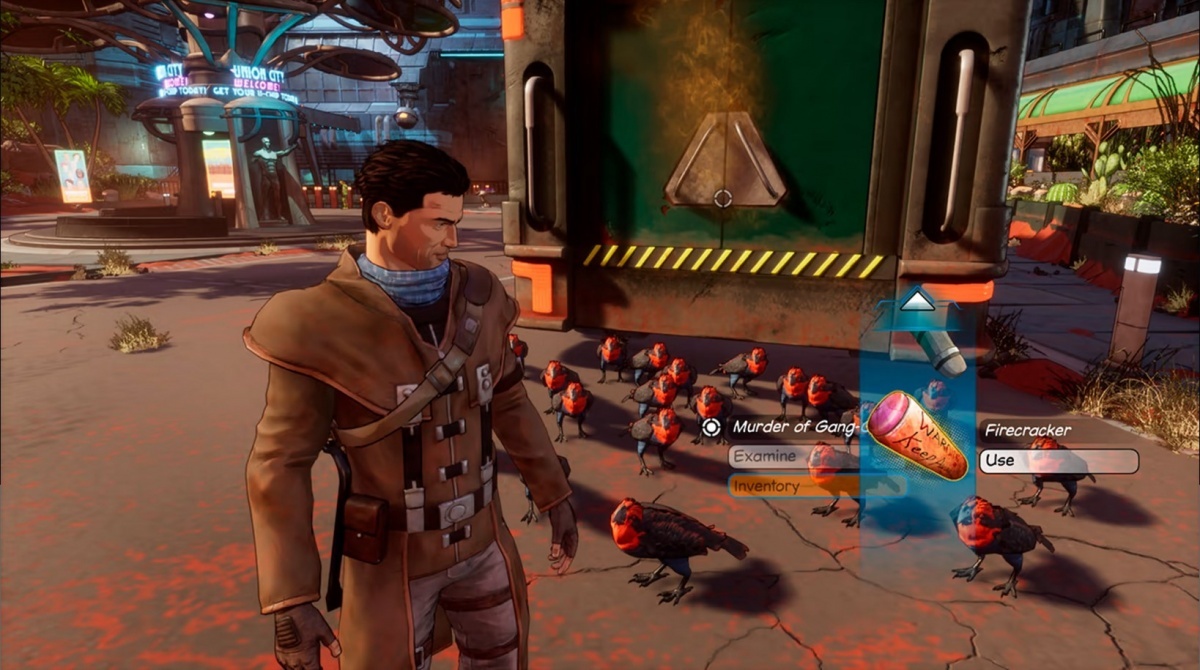Beyond a Steel Sky (Nintendo Switch) Review
By Michael McCann  12.02.2023
12.02.2023

We're living in the age of revival. Everything that once was is back again; or is, at least, fairly likely to make an imminent comeback. Spyro the Dragon, Shenmue, Ghostbusters, ABBA, Inspector Gadget, Inspector Morse, Bill, Ted. Even *gasp* Medievil was subject to the remake treatment in 2019 and again, as this very sentence is being written, a new Monkey Island is announced and situated on the horizon from originators Ron Gilbert and Dave Grossman. Whatever the people want, or can scantily remember, so it shall be; likely a result of an audience recently bestowed with spending power and the creators that make the games, both longing for a return to simpler, better, more innocent times at Ridgemont High. Because they were, weren't they!? Along the way, there have been hits and there have been misses but, regardless of the perceived outcome, the danger in revisiting dormant IP is forever present. And this is the context in which long-time coming Point-and-Click sequel Beyond a Steel Sky finds itself.
The chasm that divides nostalgia and reality is not a trifling matter. There is a risk of stripping back the rose-tinted romanticism of what once was and will never be again. Trading it in - in exchange for something that doesn't feel quite the same or even something much, much worse: mundane. Ergo, revisiting the tangible can kill an intangible memory. Revolution Software's second ever Point-and-Click adventure, Beneath a Steel Sky, released in 1994 on MS-DOS and Amiga; platforms that are, as the kids would say, by now, ancient artefacts. Its acclaim has persisted and even grown over the years (in part due to freeware and remastered editions, which are widely accessible on modern hardware, and highly recommended to check out) but now, after a 25-year franchise hiatus, it's making like Corey and Topanga Matthews, and everything else that was once held dear.
Beneath a Steel Sky is noted for being a creative collaboration between Revolution Software co-founder, Charles Cecil, and celebrated 2000 AD and Watchmen artist, Dave Gibbons. It told a dystopian tale that blended a playful wit with loftier, adult themes and established itself as a middle ground between that of the tones present in other titles dominating Point-and-Click in the 90s. It's well-remembered for this creative partnership and has largely stood the test of time, with many citing it as an all-time classic of the genre. It has this recognisable quality of British quintessence running through its veins, unique unto itself and is possibly component to that what forms much of its lasting appeal. A lot has changed within the industry though over time, but by bringing back key production and writing staff for the sequel, Beyond a Steel Sky, it doesn't betray the original's memory at all.

That's not to say that modern allowances haven't been made or are indeed going to be inevitable. The most significant departure between this and the 1994 instalment, at least at surface level, is in the graphics department. What once was lush Deluxe Paint-made pixel art backgrounds and sprites are now, well, 3D and made in the Unreal engine. This puts it bluntly, but it should be addressed, as there is a tendency to force a value judgement or heap expectation on a title based on a comparison of one visual style to that of a pre-existing and fondly remembered style. It's a divergence of shape that only exists in the abstract, and with an instinct that it is directed by the harsh reality of making a sequel happen at all; certainly in this instance. Fears of it being a trade-off or less-than however are largely unfounded. The desire for things to stay the same is largely axiomatic in nature (there is plenty of evidence for this on the subject of graphics alone) and it more than likely doesn't translate into anything that's tangible enough counter to the intrinsic benefits inherent by taking a more historically relevant approach to the design. Excluding some minor and infrequent graphical issues such as pop-in, what seems to be transparency errors on one or two 2D assets, and otherwise character constraint issues that (pun intended) rear their head when cutting between action (thus delaying animation for half a second whilst the game adjusts for said character to face the camera) the cartoony 3D style works well. Only a handful of locales are visited in Beyond a Steel Sky but it is a panegyric to the art direction that it could be said it is highly successful in creating a sense of a wider, lived-in world outside of that of the immediate frame of view. One that is equal parts inviting and foreboding. It's abundantly clear that much thought has gone into making the visual design language consistent and immersive, and never is this more evident than when looking out upon the city skyline, which consistently awes.
The narrative set-up of Beyond a Steel Sky begins when protagonist Robert Foster's retirement, and a fishing excursion in The Gap, a Mad Max-style future-rural-desert locale, is abruptly cut short by the appearance of a machine of unknown origin and a small bout of child abduction. That old chestnut. Although that description might not make it seem like it, it ends up being a rather straightforward MacGuffin for a rather straightforward narrative. Clichés scatter themselves throughout many of the set pieces, story beats and character arcs but this is by no means a pejorative observation. What transpires within the boundaries of Beyond a Steel Sky's narrative set up is ultimately an exceptionally enjoyable and engaging story, packed with lots of mystery, tension, lots of good jokes, twists, turns, mischief and a cast of likeable, well-defined characters (save for perhaps the girl that communicates in "yes" and "no's"). Moreover, it is an excuse to return to Union City, where Foster learns that things aren't quite how he left them at the end of the previous game.

The writing often flirts with heavier sci-fi concepts; a society that is obsessed with social credit, robot bigotry and the pros and cons and indifferences of instating a utopian AI governance. These subjects are dealt with a light hand and are almost always in service to the characters, scenarios and overall structure of Beyond a Steel Sky but the tension it creates is welcome and always present. In tandem with the world-building it paints a convincing picture of a future society that could quite possibly come to exist. Like Men in Black 3. It's a romp.
Moving away from pointing and then subsequently clicking, direct control is now taken over Robert Foster with the left control stick. Unsurprisingly then, camera control is assigned to the right stick, which also positions an aiming reticule, the main means of interaction, that highlights over interactable objects and characters. It's a control scheme that'll be familiar to anyone who has played a modern 3D title in the last 30 years or so, yet it is far more clunky, too. This is also true of every strict adventure game that has made the transition to 3D before it and (although Cubed3 would love to know if there is one!) no-one has really solved this issue of how to represent this particular genre when incorporating 3D navigation into the fold. In this instance, running in anything other than a straight line will result in the camera veering and turning involuntarily towards the input direction, jarringly so, and getting around is otherwise generally a little sluggish and awkward. Thankfully though, fluid controls are not critical for the enjoyment of this type of title, which absolutely can (and probably should) be taken at a slower pace. It's not really the point. It's more about the story, writing and lateral thinking involved to solve puzzles in which to progress - and Beyond a Steel Sky mostly nails all of these key aspects with aplomb.

It's only really the first major puzzle in Beyond a Steel Sky that feels like a misstep. This may be user-specific, but this first puzzle was one of the most challenging, multi-layered and abstract puzzles within the entire experience - limiting the exploration to one sparse area and locking off the main interest of Union City, which is a far more stimulating and engaging space to be in. It's clear why this was done: to act as a tutorial area and ensure players are familiar with every mechanic Beyond a Steel Sky has to throw at them before getting into it properly. However, the solution (or solutions) in this example uses a sledgehammer to crack a nut. It is a sincere hope that this section won't turn players away as it's an odd, and oddly placed, exception in an otherwise excellently sequenced and paced puzzle-adventure experience. That being said, it does highlight the hint system found within the main menu, which offers increasingly transparent hints upon multiple executions, though also after a short cooldown providing pondering time in between. Even if things do get too difficult, this hint system will eventually outright tell one the solution for progress. Even in this instance, many solutions will incorporate clever little jokes or ideas as reward, one such being Robert Foster stating that he'll need to call on his extensive engineering background to fix a broken bollard, and then proceeding to kick it.
One other gameplay innovation comes in the form of the Hacker Tool. The Hacker Tool can be equipped at any time, and it grants Robert the ability to hack into any electronic system within Union City and then alter its programming. Want to swap out the order of operation for a worker robot with a vending machine? Make it so, as Captain Picard would say. It's clever, well implemented and designed, and is utilised in some of the best puzzle solutions in Beyond a Steel Sky. It is further a mechanic that opens up so many gameplay possibilities which, even if there's a danger of it becoming too complicated, confusing or overused, would be wonderful to see expanded on in, or influence, future titles. Imagine! It could potentially offer multiple avenues for progress.

Cubed3 Rating
Very Good - Bronze Award

It is probably more often than not that long-time coming revivals don't stick the landing. Rather, they often feel cynical, desperate or misguided. Take Steps, for example. This absolutely is not the case with Beyond a Steel Sky. The writing and the way it weaves everything together honestly puts some of the biggest budget AAA movie titles to shame. Yes, there are some rough edges afforded by modern ascribe and default, but the fundamentals of a good story and adventure game are all present. More important is that it has a personality unique unto itself. It's clear why Revolution Software have such a loyal fanbase after all of these years.
Comments
Comments are currently disabled

 Sign In
Sign In Game Details
Game Details
 None
None  None
None  None
None  None
None  Subscribe to this topic
Subscribe to this topic Features
Features





 Top
Top

